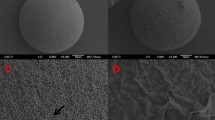Play all audios:

ABSTRACT _Paramecium caudatum_ is a very suitable object for observing the regeneration of the surface of Protozoa. The cell surface of _Paramecium caudatum_ is composed of pellicula and
cilia which are distributed evenly all over the cell surface. Access through your institution Buy or subscribe This is a preview of subscription content, access via your institution ACCESS
OPTIONS Access through your institution Subscribe to this journal Receive 51 print issues and online access $199.00 per year only $3.90 per issue Learn more Buy this article * Purchase on
SpringerLink * Instant access to full article PDF Buy now Prices may be subject to local taxes which are calculated during checkout ADDITIONAL ACCESS OPTIONS: * Log in * Learn about
institutional subscriptions * Read our FAQs * Contact customer support SIMILAR CONTENT BEING VIEWED BY OTHERS ULTRASTRUCTURAL EXAMINATION OF CRYODAMAGE IN _PARACENTROTUS LIVIDUS_ EGGS DURING
CRYOPRESERVATION Article Open access 15 April 2024 CHEMICAL FIXATION CREATES NANOSCALE CLUSTERS ON THE CELL SURFACE BY AGGREGATING MEMBRANE PROTEINS Article Open access 20 May 2022
INVESTIGATION OF POSTMORTEM CHANGE IN THE HUMAN CORNEAL EPITHELIUM VIA IMPRESSION CYTOLOGY Article Open access 06 June 2025 AUTHOR INFORMATION AUTHORS AND AFFILIATIONS * Department of
Biology, Medical Faculty, Purkyne University, Brno, Czechoslovakia R. JANISCH Authors * R. JANISCH View author publications You can also search for this author inPubMed Google Scholar RIGHTS
AND PERMISSIONS Reprints and permissions ABOUT THIS ARTICLE CITE THIS ARTICLE JANISCH, R. Sub-microscopic Structure of Injured Surface of _Paramecium cadatum_. _Nature_ 204, 200–201 (1964).
https://doi.org/10.1038/204200b0 Download citation * Issue Date: 10 October 1964 * DOI: https://doi.org/10.1038/204200b0 SHARE THIS ARTICLE Anyone you share the following link with will be
able to read this content: Get shareable link Sorry, a shareable link is not currently available for this article. Copy to clipboard Provided by the Springer Nature SharedIt content-sharing
initiative
